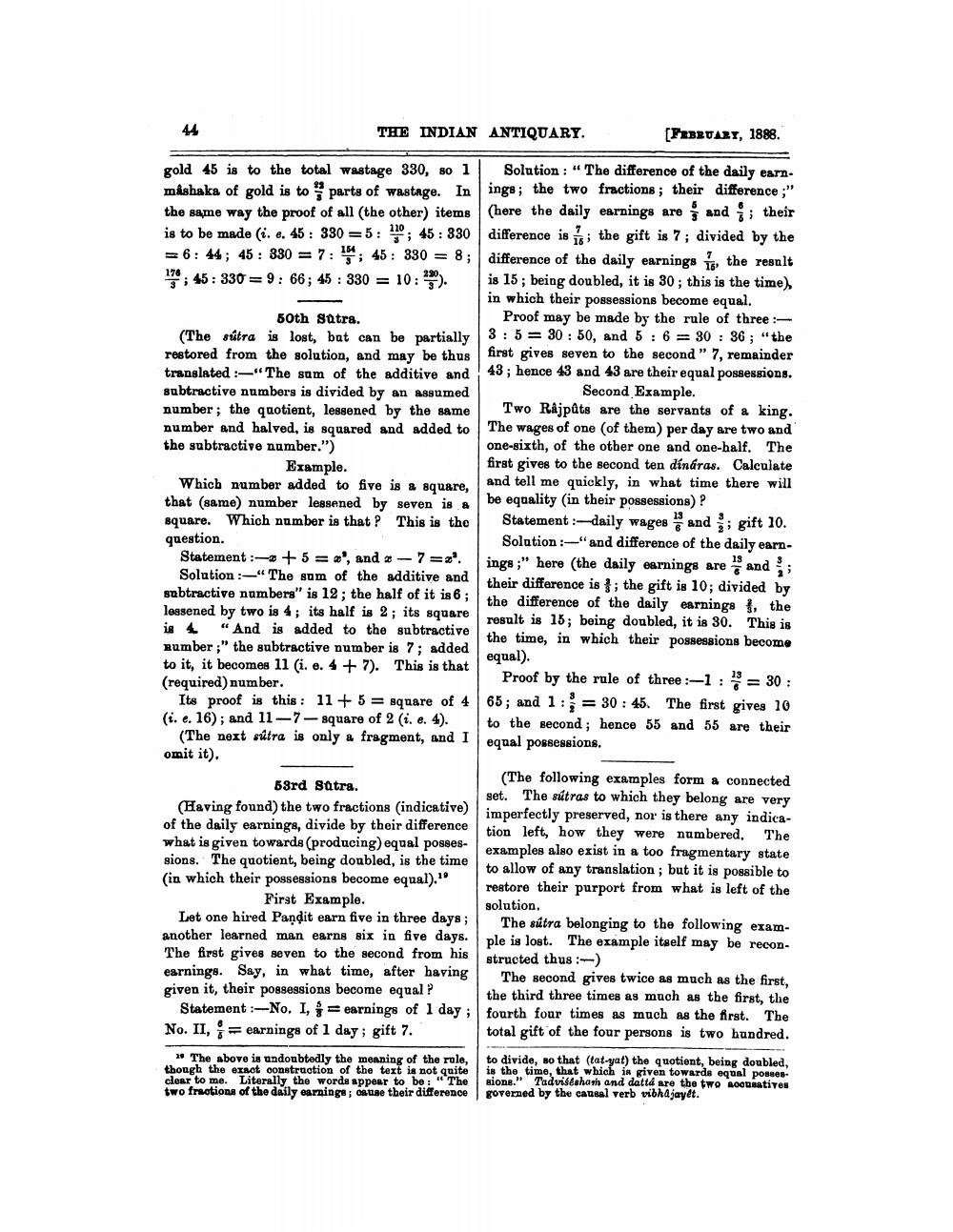________________
THE INDIAN ANTIQUARY.
(FEBRUARY, 1888.
gold 45 is to the total wastage 330, 801 Solution : "The difference of the daily earn. mashaka of gold is to parts of wastage. In inge; the two fractions; their difference ;" the same way the proof of all the other) items (here the daily earnings are and their is to be made (i... 45 : 330 = 5: 10; 45: 330 difference is ; the gift is 7; divided by the =6: 44 ; 45: 330 = 7: 1:45: 330 = 8; difference of the daily earnings in the result 170; 45: 330 = 9: 66; 45 : 330 = 10:17). is 15; being doubled, it is 30; this is the time)
in which their possessions become equal. 50th sutra.
Proof may be made by the rule of three : (The sútra is lost, but can be partially 3:5 = 30 : 50, and 5 : 6 = 30 : 36; "the restored from the solution, and may be thus first gives seven to the second " 7, remainder translated :-"The sum of the additive and | 43; hence 43 and 43 are their equal possessions. subtractive numbers is divided by an assumed
Second Example. number; the quotient, lesgened by the same
Two Rajputs are the servants of a king. number and halved, is squared and added to The wages of one (of them) per day are two and the subtractive number.")
one-sixth, of the other one and one-half. The Example.
first gives to the second ten dínáras. Calculate Which number added to five is a square,
and tell me quickly, in what time there will that (same) number lessened by seven is a be equality in their possessions)? square. Which number is that? This is the Statement :-daily wages and ; gift 10. question.
Solution :-"and difference of the daily earnStatement :- +5= ', and -7='. inge;" here (the daily earnings are and; Solution :-“The sum of the additive and
their difference is }; the gift is 10; divided by subtractive numbers" is 12; the half of it is 6;
the difference of the daily earnings , the lessened by two is 4 ; its half is 2; its square
result is 15; being doubled, it is 30. This is is 4. "And is added to the subtractive
the time, in which their possessions become number;" the subtractive number is 7; added
equal). to it, it becomes 11 (i. e. 4 + 7). This is that (required) number.
Proof by the rule of three:-1: * = 30 : Its proof is this: 11+ 5 = square of 4 65; and 1: = 30 : 45. The first gives 10 (i. e. 16); and 11-7-square of 2 (i. e. 4). to the second; hence 55 and 55 are their
(The next sútra is only a fragment, and I equal possessions. omit it).
(The following examples form a connected 58rd Satra.
set. The sutras to which they belong are very (Having found) the two fractions (indicative)
imperfectly preserved, nor is there any indicaof the daily earnings, divide by their difference
tion left, how they were numbered. The what is given towards (producing) equal posses
examples also exist in a too fragmentary state sions. The quotient, being doubled, is the time
to allow of any translation ; but it is possible to (in which their possessions become equal).""
restore their purport from what is left of the First Example.
solution. Let one hired Pandit earn five in three days; The sútra belonging to the following examanother learned man earns six in five days.
ple is lost. The example itself may be recon
nle is lost. The aramnle itself mar The first gives seven to the second from his
structed thus :-) earnings. Say, in what time, after having
The second gives twice as much as the first, given it, their possessions become equal ?
the third three times as much as the first, the Statement :-No, I, f = earnings of 1 day ; | fourth four times as much as the first. The No. II, ;= earnings of 1 day; gift 7. total gift of the four persons is two hundred.
* The above is undoubtedly the meaning of the role, to divide, so that tat-yat) the quotient, being doubled, though the exact construction of the text is not quite is the time, that which is given towards equal ponses clear to me. Literally the words appear to be: "Thesions." Tadvislahath and data are the two AGDatives two fractions of the daily earninga; on use their difference governed by the causal verb vibhdjayet.




